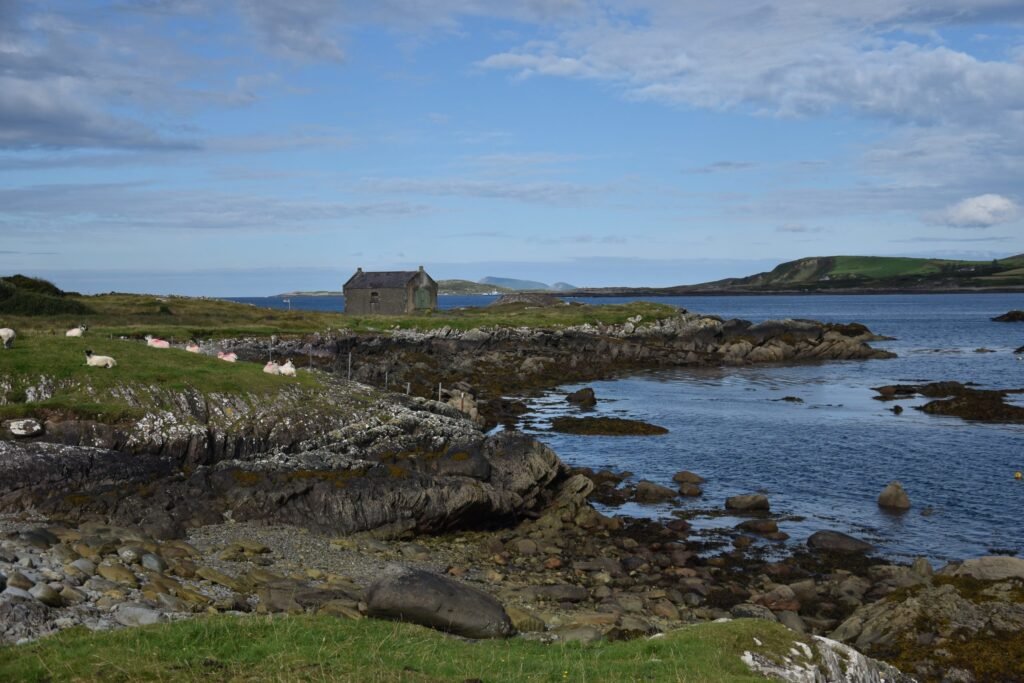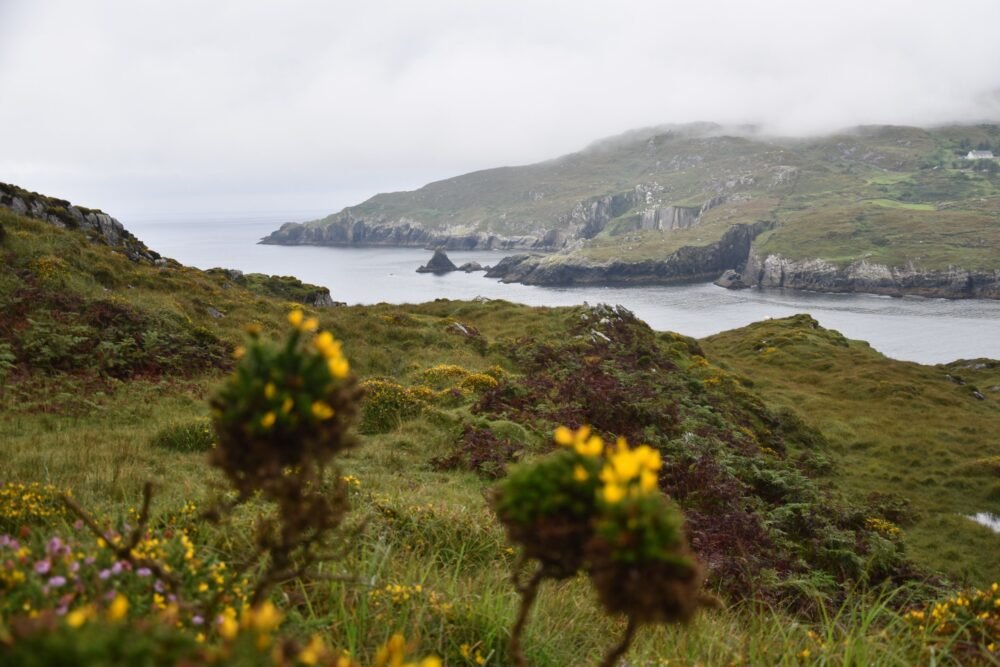Walking the Beara Way: alone but not lonely

Sheep and cow pastures up and down lead the Beara Way through the mountains of Ireland. Known as one of the most unspoiled landscapes in the southwest, Covid-19 makes the Beara Peninsula a deserted place. It becomes clear that solitude is not necessarily a bad thing.
With a loud smacking sound, the hiking boots sink into the mud. It doesn’t take long before not only shoes and socks, but both feet are soaking wet. Now every step feels like stepping into a puddle in your bare feet. Like in a time-lapse video, the clouds pass by at top speed. Mostly they are harmless and it stays dry. Sometimes, however, they get stuck in the Caha Mountains and make it impossible to see further than 50 meters.
Then only the outlines of the sheep are recognizable. But suddenly the clouds move on, and a short view of the Atlantic on the one side, and the mountains on the other, is possible. I stop for a moment, enjoy the view, breathe in and out deeply.

Stradling the Cork and Kerry regions, the Beara Peninsula is one of the five fingers jutting into the Atlantic Ocean in southwestern Ireland. The Ring of Kerry and the Dingle Peninsula attract tourists from all over the world every year, while nearby Beara is considered a well-kept secret. Over a total of 196 kilometers, the circular trail laid out in the early 1990s, leads through magnificent mountain landscapes and along wild stretches of coastline. Those who walk the route, already sparsely traveled before Corona, don’t see a soul for hours.
“We’ve been waiting for you,” says the owner of the first accommodation, braiding her daughter’s hair on the balcony. The start and end point of the Beara Trail, which is in total about 200 kilometers long, is the village of Glengarriff. Here, people drink their pints outside and stroll along the harbor at sunset.
One of the people I met is the Irishman Eric. Without a wife or children, he explores his own homeland this year. The former policeman from Cork starts the first stage, from Glengarriff to Adrigole, at the same time as me. The first five kilometers through the forest, along the Magannagan River, we walk together, talking about German and Irish stereotypes.
Then the hike begins, parting you from everyday life and the rest of the world for several days. A kind of ladder guides you to a sheep pasture, over which it goes steeply up the mountain. It doesn’t take long before the isolated buildings in this area can only be seen from such a distance that they look like little toy houses. Now we continue on the trails that will make up the bulk of the hike. Mostly, you trudge cross-country over sheep and cow pastures, up and down mountains through mud and streams.

Only black posts with the yellow trail sign, a male figure with a walking stick and backpack, point you in the right direction. Shortly after the trail increases in gradient, I have to leave Eric, who is struggling with knee problems. From then on I don’t meet another soul until I arrive at Adrigole, my destination after 18 kilometers.
From there and for the first three kilometers of the route towards the tip of the peninsula, the feet stay dry. After climbing a stream with impressive views of mountains, pastures and waterfalls, the foothills of the 682-meter Hungry Hills soon disappear in the mist. The name probably came from a misinterpretation of Angry Hill.
Now I have to stop more often to look for the trail sign. For the first time, a queasy feeling arises. “Are you scared?” the owner at the first bed and breakfast had asked. That would be an exaggeration, but it is something to consider if traveling alone as a woman, even in Ireland. “All the people you meet will be friendly,” she had assured me. “And the wildest animal you can run into is a squirrel.”
I didn’t encounter any squirrels and hardly any people either. Instead, I met many cows, some of whom made themselves comfortable right on the hiking route. Some detours are necessary to avoid getting too close to them and their calves. After circling around the herd of cows, the route continues along a raging river and through knee-high grass for 24 kilometers towards the destination of Castletownbere. It’s the largest town on the peninsula with about 800 inhabitants. For now, most of the pubs remain closed.
Virtual tourism: new choices – new normal
In the town centre, the car ferry departs eight times a day in summer to take passengers to Bere Island, which offers breathtaking views of rocky coasts. Somewhat higher up, dense fog lends a mystical ambience to Bronze Age deposits and standing stones. Remains of signal towers, military fortifications and barracks remind us of the British, who used the island because of its strategic location. The two “Martello Towers”, built at the beginning of the 19th century to protect the port of Castletownbere, are still visible for a long time on the next stage.

After a short climb into the mountains, the easily walkable paths of the fifth stage do not require full concentration for the first time in order not to land on your butt. At about the halfway point, hikers can briefly leave the trail to get a better view of the surrounding hills and the Atlantic Ocean from one of the mountains. Those who put up with the extra climb are rewarded with a breathtaking view.
With new energy, after the descent through forests and field paths, I continue towards Allihies, the last village at the very tip of the Beara Peninsula. While most hikers visit Dursey Island from here, to which Ireland’s only cable car leads, I decide to change my plans: instead of three smaller ones, I’ll make two big hikes towards my destination. With 33 kilometers from Eyeries to Lauragh this will be the longest leg. The route can also be run in two stages, because after about half of it, you arrive in the small village of Ardgroom.
There I meet William, who is just filling up his provisions. Actually, the Irishman wanted to hike this year with his wife on Corsica. However, this fell flat because of the pandemic, so he’s walking the Beara Trail for the second time. “I love this route,” says the 56-year-old. Setting off, I meet William again on the last section of the trail. The teacher notices that I’m knackered after some mountain climbs and the 25 kilometers I’ve already walked, so he offers me energy bars and distracts me with adventurous camping stories.

After a short section through a gloomy rhododendron forest, we reach Lauragh. A multi-course dinner for €18 is served by the owner of the Mountainview Bed and Breakfast, including stories from the sewing box of a genuine Irishwoman. German and Danish hikers are usually her main source of income. This year, it’s almost exclusively Irish visitors. They’re coming by car, though. “The Irish are not made for walking around in the mountains,” says her husband, who runs a small farm with cows and sheep around the house.
On a small hill between two lakes, with a waterfall in the background, just beyond Lauragh is the Uragh Stone Circle. Presumably, the stone circles, which can be found all over Ireland, were used as burial sites and places of assembly. But above all, they are known as spiritual places, where people still draw new energy and feel a special connection to the earth.
It is not until the evening that William tells me how to enter the arrangement of upright stones correctly, namely always through the two largest stones in the east. In the circle you always move clockwise. “Then you listen to yourself and feel which stone you feel most attracted to,” William says. This is the one that gives you the most strength.

Even though I was not aware of this approach, I enjoy the spectacular sight of the five-part megalith all to myself for about ten minutes. Then one car after another drives along the narrow path until there are only a few more metres to walk – that’s it for the solitude.
So at least the change is not quite so great when I arrive at my destination, Kenmare, which lies between the Ring of Kerry and the Ring of Beara. Here, people stroll through the streets and treat themselves to what is supposed to be Kerry’s best coffee at the French bakery, Maison Gourmet. Both Covid-19 and the loneliness of the past weeks of my trip seem to have been blown away. Solitude is nice – for a while. Certainly, this won’t be my last solo trip.